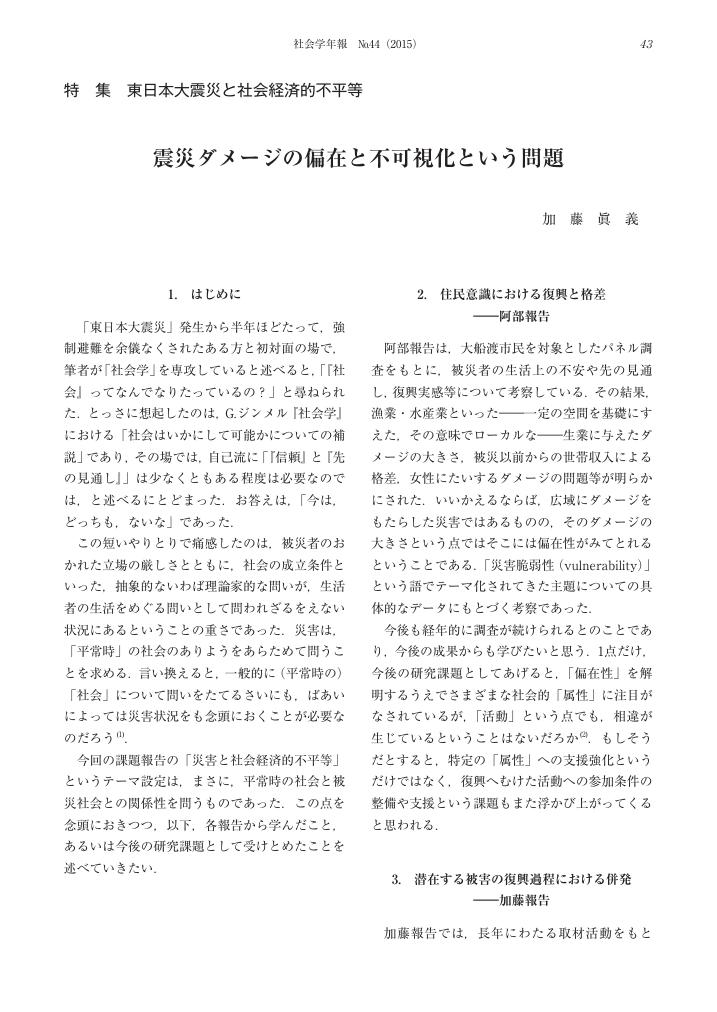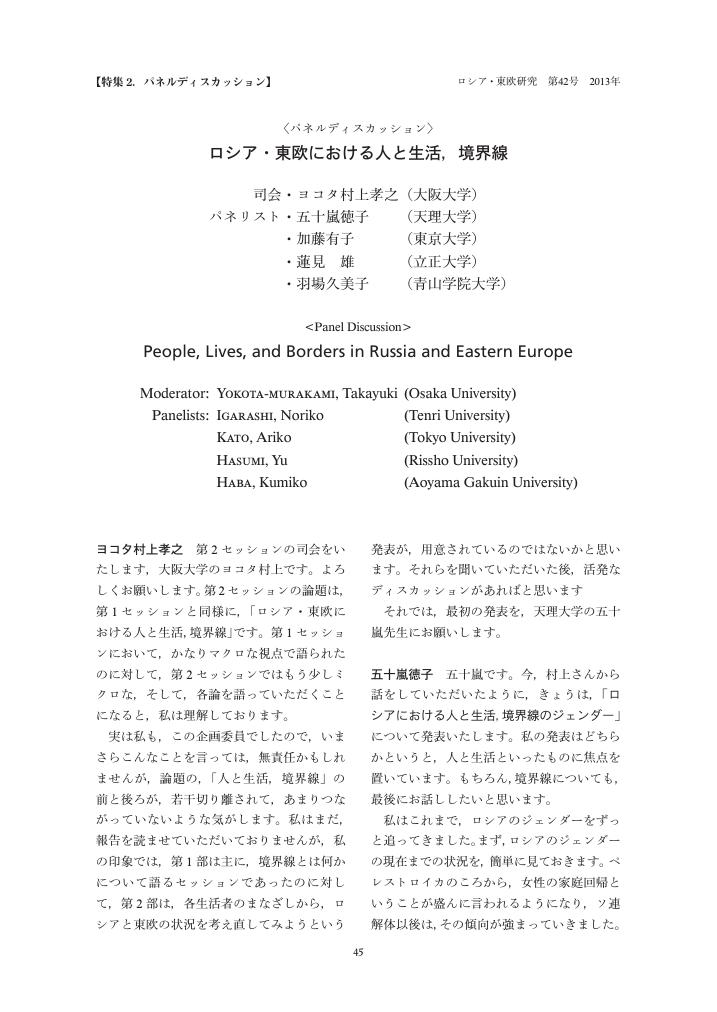1 0 0 0 OA 超音波による有機液体の分解反応
- 著者
- 加藤 隆二
- 出版者
- The Japan Society of High Pressure Science and Technology
- 雑誌
- 高圧力の科学と技術 (ISSN:0917639X)
- 巻号頁・発行日
- vol.6, no.3, pp.159-166, 1997-08-20 (Released:2009-08-07)
- 参考文献数
- 31
In this article, an effect of ultrasound on chemical reactions is reviewed. The sonochemical reaction proceeds at a hot spot produced by cavitation of bubble, i. e., creation and collapse of a bubble in liquid. Temperature and pressure at the hot spot exceed 5000 K and 100 MPa, respectively, therefore, pyrolysis of solvent can occur. We present experimental technique and our recent results of sonochemical decomposition of organic liquids and synthesis of C60 from liquid benzene.
- 著者
- 江端義夫 加藤正信 本堂寛編
- 出版者
- 学習研究社
- 巻号頁・発行日
- 1998
1 0 0 0 OA 天気晴朗ならば株高し
- 著者
- 加藤 英明 高橋 大志
- 出版者
- 日本ファイナンス学会 MPTフォーラム
- 雑誌
- 現代ファイナンス (ISSN:24334464)
- 巻号頁・発行日
- vol.15, pp.35-50, 2004-03-31 (Released:2018-12-07)
- 参考文献数
- 11
本稿は,日本の株式市場と天候の関係を過去40年間の日次データを基に分析したものである.伝統的ファイナンスの立場にたてば,天候が株価に対し影響を与えると考えることは難しい.しかし,分析の結果は,株価の動きと天候の間には,統計的に有意な関係があることを示している.さらに,その関係は,これまでに報告されている月曜効果,1月効果などのアノマリーを考慮しても,強く残ることが確認された.これらの結果は,伝統的ファイナンスの仮定している合理的な意思決定では投資家行動を説明できないことを示唆している.
1 0 0 0 OA 原現象について
- 著者
- 加藤 好光
- 出版者
- ゲーテ自然科学の集い
- 雑誌
- モルフォロギア: ゲーテと自然科学 (ISSN:0286133X)
- 巻号頁・発行日
- vol.1990, no.12, pp.78-99, 1990-10-30 (Released:2010-02-26)
- 参考文献数
- 23
1 0 0 0 OA 失語症者におけるコミュニケーション補助手段の有効性について
- 著者
- 小嶋 知幸 宇野 彰 加藤 正弘
- 出版者
- The Japan Society of Logopedics and Phoniatrics
- 雑誌
- 音声言語医学 (ISSN:00302813)
- 巻号頁・発行日
- vol.32, no.4, pp.360-370, 1991-10-20 (Released:2010-06-22)
- 参考文献数
- 7
- 被引用文献数
- 3 2
22例の失語症者に対して, 実用的なコミュニケーション補助手段として, 日常生活上重要性が高いと考えられる事物の写真, 絵, 文字をカテゴリー別に貼付したノート (以下コミュニケーションノート) を作成し, 活用の状況を調査, 検討した.その結果, 1.コミュニケーションノートを自発的に活用するためには, 知的機能, コミュニケーションへの積極性, 社会的関心, コミュニケーション環境などの条件を良好に満たしている必要がある, 2.ノートは, 比較的発症初期から実用的なコミュニケーション補助手段となりうる, 3.ノートが有効でない話題もあり, 話題に応じたコミュニケーション手段の使い分けが必要である, 4.ノートの活用に際しては, 患者のみならず, 日常生活上患者と身近に関わる家族や介護者を含めた総合的な指導が必要である, と考えられた.
1 0 0 0 OA 査読者から見た論文作成に至るまでに検討すべき研究倫理
- 著者
- 加藤 憲
- 出版者
- 一般社団法人 日本医療・病院管理学会
- 雑誌
- 日本医療・病院管理学会誌 (ISSN:1882594X)
- 巻号頁・発行日
- vol.57, no.1, pp.46-49, 2020-04-24 (Released:2020-04-28)
- 参考文献数
- 5
- 著者
- 加藤 佳奈
- 出版者
- 日本経営学会
- 雑誌
- 經營學論集 第89集 日本的経営の現在─日本的経営の何を残し,何を変えるか─ (ISSN:24322237)
- 巻号頁・発行日
- pp.F9-1-F9-2, 2019 (Released:2019-09-26)
1 0 0 0 OA 〈「福島」の現在〉とその後
- 著者
- 加藤 眞義
- 出版者
- 東北社会学会
- 雑誌
- 社会学年報 (ISSN:02873133)
- 巻号頁・発行日
- vol.45, pp.1-3, 2016-12-26 (Released:2018-09-25)
- 参考文献数
- 6
1 0 0 0 OA 大震災とアスベスト ――「復興」に隠された被害の構図――
- 著者
- 加藤 正文
- 出版者
- 東北社会学会
- 雑誌
- 社会学年報 (ISSN:02873133)
- 巻号頁・発行日
- vol.44, pp.25-38, 2015-07-16 (Released:2018-03-28)
- 参考文献数
- 9
アスベスト(石綿)は他に類を見ない有用性から産業革命以降,各国で大量使用されてきた.その用途は3千種類に及んだ.しかし,髪の毛の5千分の1の微細な石綿繊維は,吸引すると長い潜伏期間をへて中皮腫や石綿肺などの病気を引き起こす.生産・流通・消費・廃棄の経済活動の全局面で被害を起こす「複合型ストック災害」(大阪市大名誉教授・宮本憲一)とされる. 微細な死の棘が一気に拡散されるのが,大震災のときだ.激しい揺れで倒壊した建物からは,建材などに内在していた石綿が周囲に飛散する.1995年の阪神・淡路大震災では大量の建物が倒壊し,粉じんが舞いあがった.20年あまりが過ぎ,がれき処理に携わった労働者の間で発症が相次いでいる.震災で家族や自宅,工場などを失い,さらに時をへて石綿の病気にかかってしまう.この不条理こそが震災アスベストの特徴である.この教訓は2011年の東日本大震災の被災地できちんと生かされているのだろうか.宮城県石巻市や仙台市などでは飛散対策の不備やマスクの装着の不徹底など飛散・吸引のリスクを各所で感じた. アスベスト被害は使われた範囲が広い分,被害の形もまた多様である.有害と知りつつも「管理して使えば安全」として十分な規制を怠る.その結果,大勢の市民が犠牲となり,いまも危険にさらされ続ける.その姿は,東京電力福島第一原発事故を引き起こし,迷走したままの原子力政策とも重なる.
1 0 0 0 OA 震災ダメージの偏在と不可視化という問題
- 著者
- 加藤 眞義
- 出版者
- 東北社会学会
- 雑誌
- 社会学年報 (ISSN:02873133)
- 巻号頁・発行日
- vol.44, pp.43-45, 2015-07-16 (Released:2018-03-28)
- 参考文献数
- 4
1 0 0 0 OA 医療安全管理者としての医師と看護師 ―自由記載からみた問題意識の相異―
- 著者
- 加藤 英一 田村 京子
- 出版者
- 東北社会学会
- 雑誌
- 社会学年報 (ISSN:02873133)
- 巻号頁・発行日
- vol.39, pp.87-97, 2010-07-16 (Released:2014-02-07)
- 参考文献数
- 41
医療安全管理者は,看護師,医師,薬剤師といった複数の異なった医療資格者によって担われている.但し,この中でも医師と看護師の占める割合が特に大きい.本稿は医療安全管理者が,日常の業務の中で抱いている問題点の分析という観点から,異なった医療資格者間の中でも,医師と看護師における安全業務に対する問題意識の相異を調査を通して明らかにしている. 結果として,同じ医療安全管理者でありながらも,異なった医師と看護師とでは異なった問題意識を抱いていることが明らかとなった.医師は医療安全業務に対して,その問題の本質は社会や国のレベルにあると捉えているがゆえに,「国レベルの問題」に対して関心を抱く傾向にあり,他方看護師は医療安全業務を身近な組織の問題として捉えているがゆえに,「病院組織内の問題」に対してよりその関心を抱く傾向にある.
1 0 0 0 OA 有害事象における不信増幅のプロセス ―医療訴訟の事例分析から―
- 著者
- 千葉 太郎 加藤 明子 浜渡 千春
- 出版者
- 一般社団法人 日本心身医学会
- 雑誌
- 心身医学 (ISSN:03850307)
- 巻号頁・発行日
- vol.51, no.5, pp.408-415, 2011-05-01 (Released:2017-08-01)
- 参考文献数
- 14
近年は医療に関する種々の問題が表面化しており,これらの問題は過重労働を介して医療従事者の健康を損ねることにつながっていると思われる.そこで,問題点と過重労働との関連や医療従事者の健康を守るための対策について,特に勤務医を対象として考察した.わが国はOECD諸国の中で人口あたりの医師数は少なく,また病院数は減少傾向にある.厚生労働省によると,勤務医の1週間の総労働時間は63.3時間ときわめて長い.さらには医療関係訴訟も増加している.これらの状況から,勤務医は劣悪な労働状況の中で過重労働を強いられているといえる.日本医師会の調査では,勤務医には睡眠状況の悪い者が多く,また自分の体調不良を他の医師に相談する者は少なく,悲しみを自覚する医師,死や自殺について考える医師も少なからずみられるという.さらに医師の自殺は2005年に年間90件あり,自殺率は一般の日本人と比べて1.3倍と高い.このような労働状況とその帰結としての心身の不健康は,医療費抑制政策,新医師臨床研修制度,さらに医師-患者間の関係性の希薄化などと関連すると考えられる.勤務医の健康を守るために最も重要なのは,「人的資源」としての医療従事者の健康を守ることによって国民の健康と命を守るという立場から,国が対策に取り組むことである.
- 著者
- 加藤 紫苑
- 出版者
- 日本シェリング協会
- 雑誌
- シェリング年報 (ISSN:09194622)
- 巻号頁・発行日
- vol.28, pp.140-145, 2020 (Released:2020-10-13)
1 0 0 0 OA 「オルガノン・テーゼ」から「真と美の統一」へ 同一哲学の成立に関する一考察
- 著者
- 加藤 紫苑
- 出版者
- 日本シェリング協会
- 雑誌
- シェリング年報 (ISSN:09194622)
- 巻号頁・発行日
- vol.25, pp.96-106, 2017 (Released:2019-08-06)
In dieser Abhandlung interpretiert die Autorin die Entstehung der Identitätsphilosophie Schellings als die Entwicklung vom Standpunkt der „Organon-These“– die Kunst sei das einzige wahre und ewige Organon und zugleich Dokument der Philosophie – im System des transzendentalen Idealismus (1800) zu dem der „Einheit der Wahrheit und Schönheit“, der im Dialog Bruno (1802), in den Vorlesungen über Philosophie der Kunst (1802/03) und so weiter ausführlich erklärt wird. Dabei belegt sie ihre Interpretation durch die Beantwortung der folgenden drei Fragen: 1) Was ermöglicht Schelling, das System der Kunstphilosophie aufzubauen? 2) Welches Verhältnis besteht zwischen der Darstellung meines Systems der Philosophie (1801) und dem Dialog Bruno? 3) Was ist das Hauptthema dieses Dialogs?
1 0 0 0 OA フィチーノとシェリング
- 著者
- 加藤 尚武
- 出版者
- 日本シェリング協会
- 雑誌
- シェリング年報 (ISSN:09194622)
- 巻号頁・発行日
- vol.24, pp.114, 2016 (Released:2020-03-26)
The inventions of the telescope and the microscope have forged two divergent paths of of influ- ence. The telescope demolrished the Aristotelian theory of the Universe, that celestial bodies move eter- nally, but bodies under the Moon moved to finite ends. The microscope , meanwhile, created a new metaphysical scope: Beneath the lifeless visual world there is a vibrant world that cannot seen by the naked eye. In this vibrant world Body and Soul- ,Finite and Infinite- ,Being and Nothingness exist in continuity. The continuity entails the truth that in the most fundamental structure of universe, Body = Soul, Finite = Infinite ,Being = Nothing are valid precepts.
1 0 0 0 OA 地方自治体の行政改革に関する要因分析
- 著者
- 加藤 美穂子
- 出版者
- 日本財政学会
- 雑誌
- 財政研究 (ISSN:24363421)
- 巻号頁・発行日
- vol.1, pp.264-279, 2005 (Released:2022-07-15)
- 参考文献数
- 24
本研究は,地方自治体の政策決定要因として,首長や議会など地方内部の政治的特性に注目し,計量的にその影響を明らかにしようとするものである。とくにここでは,地方自治体の意思が比較的表れやすい行政改革への取組みに注目する。今後,地方分権の進展にともない,地方財政や地方行政における自治体内部の政治的意思決定は,その重要性がより高まっていく。その過程を考察するための第一歩としても,今回,このような検証を試みている。 本稿の検証結果からは,今日の各自治体の行政改革への取組み具合は,財政状況や都市規模などの社会的・経済的環境のみならず,首長の党派性や選挙競争の程度,議会との関係といった政治的環境によってもやはり影響を受ける可能性が示唆された。
1 0 0 0 OA 青年期における“自認するキャラ”を介した友人関係と承認欲求・評価懸念との関連
- 著者
- 村井 史香 岡本 祐子 太田 正義 加藤 弘通
- 出版者
- 一般社団法人 日本発達心理学会
- 雑誌
- 発達心理学研究 (ISSN:09159029)
- 巻号頁・発行日
- vol.30, no.3, pp.121-131, 2019 (Released:2021-09-30)
- 参考文献数
- 31
- 被引用文献数
- 1
本研究の目的は,自認するキャラを対象とし,キャラ行動をすることによって,キャラを受容していくという過程が成立するかどうかを検討すること,さらにキャラ行動およびキャラの受け止め方と承認欲求,評価懸念との関連を明らかにすることであった。質問紙調査によって,中学生434名と大学生219名のデータを得て分析を行った結果,以下の3点が示された。第1に大学生は中学生よりも自認するキャラを有する者が多く,学校段階に関わらず,賞賛獲得欲求はキャラのある者の方が高かった。第2に,因子分析の結果,自認するキャラの受け止め方は“積極的受容”,“拒否”,“無関心”の3つが得られ,キャラ行動をすることでキャラを受容する過程が成立することが明らかとなった。第3に,賞賛獲得欲求だけがキャラ行動と正の関連を示し,賞賛獲得欲求に基づくキャラ行動が,キャラの積極的受容を促進することが示された。一方,評価懸念はキャラの積極的受容には負の関連を示し,キャラへの拒否には正の関連を示した。この過程は学校段階に関わらず,成り立つことが示された。賞賛獲得欲求に基づくキャラ行動は,“見られたい自分”を主体的に演出する行為であり,以上の結果はキャラが持つ肯定的な側面にも目を向けるべきであることを示唆するものであると考えられる。
1 0 0 0 OA ロシア・東欧における人と生活,境界線
1 0 0 0 OA 第二次プーチン政権のアジア・太平洋政策 ―米中ロ大国間関係の変化の観点から―
- 著者
- 加藤 美保子
- 出版者
- ロシア・東欧学会
- 雑誌
- ロシア・東欧研究 (ISSN:13486497)
- 巻号頁・発行日
- vol.2012, no.41, pp.28-44, 2012 (Released:2014-05-27)
- 参考文献数
- 71
This article explains the opportunities and problems of Russia’s foreign policy towards the Asia-Pacific region (APR) under Putin’s third presidency. On 7 May 2012, president Putin signed Executive Orders for “implementing plans for developing Armed Forces and modernizing military-industrial complex” and “measures to implement foreign policy.” The first section of this article analyzes these documents from the viewpoint of Russia’s policy towards the Asia-Pacific region and points out the need for paying attention to the changes in the security environment both in Northeast Asia and Southeast Asia during the past 12 years, which have been ignored in previous research on the background of Russia’s assertive Asia policy. The above two documents show the significant changes in the Russia’s Asia-Pacific as follows. Firstly, the former document announces Moscow’s intention to develop the Navy, first and foremost in the Arctic areas and in Russia’s Far East with the aim of protecting the Russian Federation’s strategic interests. Secondly, the latter documents showed the national interests in deepening an equal, trust-based partnership and strategic cooperation with China, strategic partnerships with India and Vietnam, and developing mutual beneficial relations with America’s traditional allies, that is Japan, South Korea, Australia and New Zealand. Given those changes, the second section of this article strives to demonstrate the qualitative changes in the relations among three major powers (the U.S., China and Russia) in the Asia-Pacific region by focusing on the trade balance, demand-supply situation of energy resources, and security issues. Finally, the third section discusses how Russia’s foreign policy towards APR will be affected by China’s advancement to the Arctic sea and the South China Sea and also the U.S. military shift to APR. In conclusion, this paper makes three points. First, unlike the old triangular relations in the Cold War era that were characterized by predominance of military capacity, both the areas of common interests and conflicts were diversified from trade, energy resources to traditional and non-traditional security issues in today’s U.S.-China-Russia relations. Second, China’s advancement to the Arctic sea through Sea of Japan has the potential to provoke the military competition between Russia and China, however this situation may offer an opportunity to deepen the cooperation between Russia and the U.S. in maritime security. Third, this article points out that the heightening tension between the U.S. and China as well as China and Vietnam in the South China Sea provides Russia with an opportunity to engage in regional affairs, for example, participation in the East Asia Summit. However, strategic partnership both with China and Vietnam complicates Russia’s attitudes towards Vietnam.







